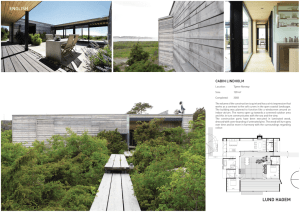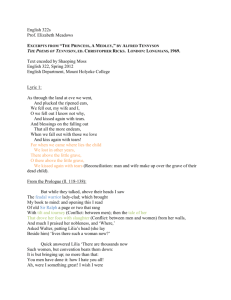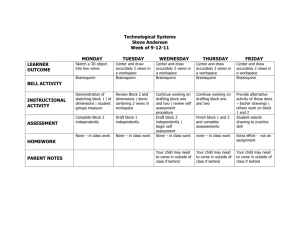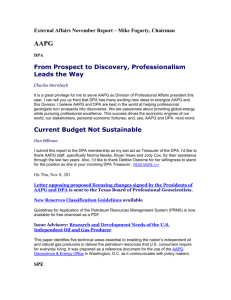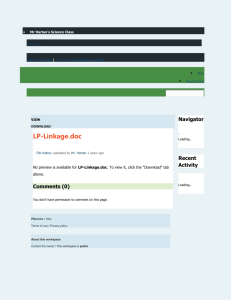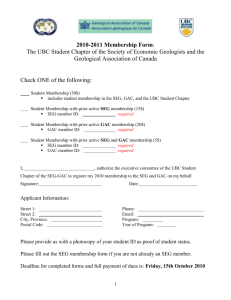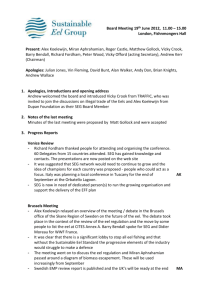Software Engineering Education and Training for Motion Picture
advertisement
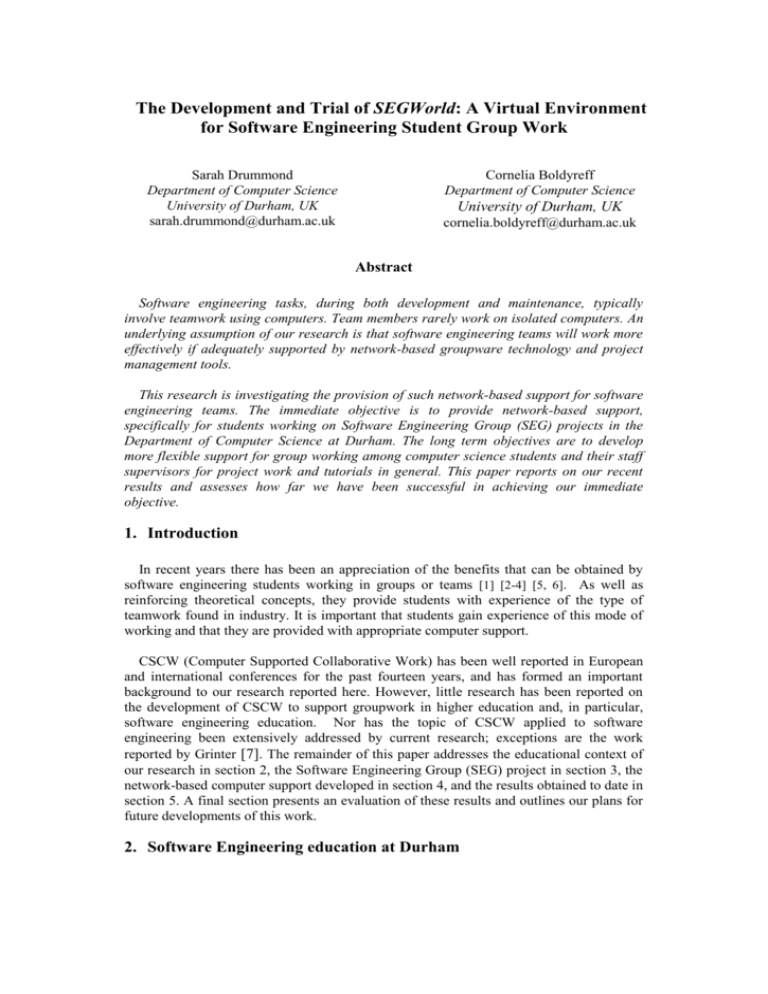
The Development and Trial of SEGWorld: A Virtual Environment for Software Engineering Student Group Work Sarah Drummond Department of Computer Science University of Durham, UK sarah.drummond@durham.ac.uk Cornelia Boldyreff Department of Computer Science University of Durham, UK cornelia.boldyreff@durham.ac.uk Abstract Software engineering tasks, during both development and maintenance, typically involve teamwork using computers. Team members rarely work on isolated computers. An underlying assumption of our research is that software engineering teams will work more effectively if adequately supported by network-based groupware technology and project management tools. This research is investigating the provision of such network-based support for software engineering teams. The immediate objective is to provide network-based support, specifically for students working on Software Engineering Group (SEG) projects in the Department of Computer Science at Durham. The long term objectives are to develop more flexible support for group working among computer science students and their staff supervisors for project work and tutorials in general. This paper reports on our recent results and assesses how far we have been successful in achieving our immediate objective. 1. Introduction In recent years there has been an appreciation of the benefits that can be obtained by software engineering students working in groups or teams [1] [2-4] [5, 6]. As well as reinforcing theoretical concepts, they provide students with experience of the type of teamwork found in industry. It is important that students gain experience of this mode of working and that they are provided with appropriate computer support. CSCW (Computer Supported Collaborative Work) has been well reported in European and international conferences for the past fourteen years, and has formed an important background to our research reported here. However, little research has been reported on the development of CSCW to support groupwork in higher education and, in particular, software engineering education. Nor has the topic of CSCW applied to software engineering been extensively addressed by current research; exceptions are the work reported by Grinter [7]. The remainder of this paper addresses the educational context of our research in section 2, the Software Engineering Group (SEG) project in section 3, the network-based computer support developed in section 4, and the results obtained to date in section 5. A final section presents an evaluation of these results and outlines our plans for future developments of this work. 2. Software Engineering education at Durham The Software Engineering I module is taught to all 2nd year undergraduate students studying in the Computer Science department. An important part of the module is the practical component that consists of the Software Engineering Group (SEG) project that runs in parallel with the Software Engineering lectures throughout the academic year. The lectures in Software Engineering I cover all the major concepts relevant to the software lifecycle activities as well as topics relevant to the management of software projects. In the SEG project, students carry out all of the main activities of the software lifecycle supplemented by intermediary tasks undertaken as supervised practical work. The intermediary tasks include e.g. introduction to desktop video conferencing, introduction to the shared workspace, domain analysis, groupwork, configuration management. The students carry out the majority of the SEG work independently in small teams. Each team has a member of staff who acts as the group’s tutor and customer. Typically students will meet with their tutor fortnightly to discuss their progress. Most students taking a degree within the department go onto study Software Engineering II in their final year. These students undertake an individual final year project (which always involves a major implementation) but rarely involves any team work, thus, the SEG project described in more detail below, is the students’ main experience of teamwork based development during their degree course. 3. The Software Engineering Group (SEG) project SEG projects have run successfully since 1984 within the Department of Computer Science. Their introduction and subsequent development has been largely motivated by a perceived need to prepare students for typical working practice found in industry. This type of project presents the first opportunity for the student to work as part of a group, to divide up work among several team members and make technical and managerial decisions as a group - a not uncommon real-life parallel. The project itself is well structured into phase’s [8] (Figure 1), and follows the classical waterfall software lifecycle model, with some optional prototyping. The waterfall model, generally implies that software development is undertaken in a series of definite steps, with no iteration, whereas in reality, software development can be carried out in parallel and iteration is common. Within the SEG project work, iteration is provided for, by allowing the students to specify changes at the beginning of each phase. McDermid discusses this type of iterative interaction in [9]. Students have the opportunity to evaluate the work of other groups as well as their own; for example, at the end of the requirements phase each group carries out an appraisal of another group’s requirements document followed by acceptance testing for the product developed by the same group. At the end of the group work, the SEGs are asked to produce a project legacy report where they take a critical look at how they have worked as a team during the project, what went wrong, how they rectified it and finally would they do it differently next time. This is a valuable learning exercise for the students. These legacy reports provide valuable feedback to all the staff involved in the SEG project. One of the major achievements of the SEG project is that it provides students with early experiences with system building concepts and practices. This meets the industrial need for graduates with experience of building systems in a team rather than experience of simply working as a collection of individual programmers as discussed by Goldberg [10]. In recognition of this there are various industrially sponsored SEG prizes awarded. Software Engineering Group Project (SEG) Process Model Preparatory Phase: 1w eek Phase 1: 5 w eeks Phase 2: 1 w eek Phase 3: 4 w eeks Phase 4: 4 w eeks Phase 5: 1 w eek Domain A nalysis Requirements Project domain research Req.A ppraisal Overview Dev. Op & Maint. Environments Interf ace, DFD Perf ormance Design A ppraisal of another groups' req. spec. Based on "7 Sins of Requirements Def inition"* Implementation & Testing Change s to r e qs . Design Method and rationale A ccept. Test Change s to de s ign Command summary Exception handling Overview design V er.& Imple f eatures Module descr. Modif ication & enhancements System org. Know n problems Imple. plan Working system of Impl & Testing strategy Rationale f or test method chosen A ssessment of system based on requirements spec. A ccept criteria Domain A nalysis report Requirements Specif ication document Requirement A ppraisal report Design document Testing Strategy report and source code A cceptance Testing report SEG Deliverables *B.Meyer, "On Formalism in Specification" IEEE Software 1985 pp6-26 Figure 1: SEG project phases and process model Having successfully established and run SEG projects, the department has considered how these could be improved to more realistically mirror industrial practice in software engineering. In particular, these considerations have given rise to studies to identify appropriate groupware technology for supporting SEG projects and the development of a virtual software engineering environment. With university funding we have been able to develop and monitor the introduction of network-based asynchronous and synchronous computer support for the SEG project [3]. We now are able to report on our experiences of developing and using the virtual software engineering environment throughout a complete academic year. 4. Creation of SEGWorld - a virtual environment for Software Engineering students Our initial studies[11] identified a need for groupware tools to enable SEG students to easily share documents and applications; we therefore investigated how we could effectively introduce an asynchronous groupware system - BSCW (Basic Support for Cooperative Work)[12] into the SEG students’ working environment. In the first phase of the development, a virtual environment, SEGWorld, based on BSCW has been developed (the BSCW system is run on a Sparc Station 20 – Solaris 2.4). SEGWorld is Web-based and essentially provides a repository for all the relevant teaching materials associated with SEG projects. A public workspace is provided, which allows all SEG students and associated staff, access to software tools relevant to student project work, and to other facilities i.e. posting general notices or queries. Private group workspaces, allow for the development and secure keeping of each group’s practical reports and project deliverables. To further support students during the SEG project, the Department of Computer Science funded a small multimedia PC laboratory dedicated for SEG student use. To better utilize the SEGLab, we have divided this space into three small offices and a common meeting area. A Web-based online booking form has been developed which permits groups to book an “office” and allows staff to monitor SEGLab usage. During the development of SEGWorld, and the introduction of desktop video conferencing we formulated a number of hypotheses about providing such technologies, i.e. how it would they be used, how they would support the students, and the importance of the role of groupware. In the following section a selection of these hypotheses will be discussed together with the supporting evidence obtained during the initial year of trial usage (a more detailed description of this work and results obtained can be found in Sarah Drummond’s MSc thesis [13]). 5. Results obtained during the trial year Throughout the academic year, the students’ usage of SEGWorld has been monitored and data collected. The data collection methods chosen for this research are, in the main, observational, questionnaires and project monitoring. This project monitoring took the form of BSCW automatically generating and emailing a list of activities undertaken each day in the group workspaces. This information includes the type of activity, student name and time. In addition to this, students were asked to complete questionnaires, and invited to take part in focus group discussions in order that their views could be collected. In total there were 72 students in groups of 6 or 7 (12 groups). Questionnaire results are based on responses from 58 students (the completion of questionnaires was not mandatory). The following hypotheses have been selected for discussion: 1. The introduction of an asynchronous shared workspace into software engineering groupworking will aid group members to organize and coordinate their work. 2. Greater use of shared workspace functionality will be made as the project progresses 3. Asynchronous communication has a more important role to play in software engineering groupwork than synchronous communication. The following subsections present each of the hypotheses and the discussion of the associated results. Hypothesis 1 The introduction of an asynchronous shared workspace into software engineering groupworking will aid group members to organize and coordinate their work. From a high level perspective, figure 2 represents the responses from individual SEG students, related to the workspace enabling better organization and coordination of their work. yes (indiv. student response) 70% 60% 50% 40% 30% 20% 10% 0% Helps organise w ork? Workspace structure useful? Better comms. w ith tutor/group? Questions Figure 2: Organization & Coordination activities In general, the students felt that the hierarchical structure of the workspace was intuitive and graphically illustrated how their work was being structured. But, as the level of decomposition of folders (directories) into sub-folders (sub-directories) increased, navigation became slow. Students commented on the lack of shortcuts to the various documents. In fact, students were simply unaware that shortcuts are possible. As SEGs have a group UNIX account in addition to their private workspace, five of the groups used both, with UNIX generally being the preferred choice because of faster system response times. The poor uptake of the communication functions within SEGWorld (i.e. email and automatic meeting facility), was due to the fact that groups met with their tutor face-toface on a regular basis, both formally (arranged meeting) and informally (i.e. at the end of a lecture), to discuss progress and/or problems. From a lower level of granularity, figure 3 highlights a selection of functions provided by the system, that was used during the SEG project. Used function (indiv. responses) 60% 50% 40% 30% 20% 10% 0% Meeting Versioning AttachedNote Catchup Workspace Functions Figure 3: Functions relating to organization and coordination These functions have been chosen because they are associated with organisation and coordination. They are as follows: Meeting - schedules a new meeting showing venue details and those invited to participate. E-mail is automatically generated to inform members of these details. Versioning - versions a document. A new version is created which becomes the current version, whilst old versions are still readily available. Attached Note - attaches a note to a specified object that is displayed to other users when they attempt to access the object. There is no formal locking mechanism for objects provided, when removed for editing etc. Catchup - A new document/object has a “NEW” icon displayed. This “NEW” icon remains regardless of how old the document/object is, unless the catchup facility is used to remove it. This distinguishes new documents from existing documents. Whilst the meeting facility was thought by group members to be useful, many did not use it because it was simpler to use existing e-mail systems. To organize a meeting via SEGWorld involved loading a browser, entering SEGWorld and then the group private workspace. To confirm attendance at the meeting involved every attendee replying in this fashion. Students were asked if they had used this function and whilst figure 3 indicates that over 60% of group members had, this figure does not reflect the actual low usage over the phases of the project. Many of the students had experimented with the meeting function during the initial SEGWorld tutorial session, but did not use it to any great extent after this. The versioning mechanism provided was easy to apply, but few of the groups used it. An interesting point noted in the results obtained via the questionnaires were that within at least two groups, all members stated they had used this function. When these results were checked against the automated daily activity logs, it was found that only two members from each of these groups were shown to have actually used the function. This anomaly may be due to inaccurate completion of questionnaires, or that the group members worked around one PC. Within all groups, one member was appointed as secretary, and often this role involved controlling the versioning of documents. The catchup function, which provides an up-to-date view of the activity i.e. new document, which has occurred within the workspace, was used very little. On further questioning, most students admitted to not being aware of what this function actually did. SEGWorld provided a central repository for all group documentation, and as such provided a graphical representation for configuration management (i.e. a historical trail for each document), and awareness of other group members activities, i.e. determining if a group member had produced or read a section of a document. This in itself helped the groups in coordinating their work by being aware of the status of a document. From an organisational viewpoint, the workspace provided each group member with some insight into the contributions being made by other members, but much of the organisational strategy developed (e.g. distribution of tasks) was in the main, undertaken through face-toface communication. Hypothesis 2 Greater use of shared workspace functionality will be made as the project progresses. The following graph (figure 4) shows the use made by SEGs, of the various functions provided by SEGWorld, during the different phases of the software lifecycle. These functions are a subset of those available, and were chosen as they represented the most common events that would occur in the process of producing a typical SEG project deliverable. The objective of logging the daily usage of these functions was to determine if the use of SEGWorld increased as the project progressed. This anticipated increase could indicate that the students were becoming more confident in using the workspace, and had overcome any initial problems. SEG: use of BSCW functions total usage - hits (all groups) 180 create 160 read 140 edit 120 delete 100 version 80 60 40 20 0 1 2 3 4 Requirements 5 6 Req Appr 7 8 Design 9 10 11 12 13 Implementation 14 accpt tim e - w eeks Figure 4: Usage of SEGWorld functions during the phases of the software lifecycle In figure 4, most activity is centered on creating and reading the requirements specification. The negligible amount of activity by most SEGs for the editing and versioning functions could indicate that they did not fully understand these functions. Rather than editing or versioning an existing document it would appear that they have deleted and then re-created the document. At this early stage in the use of the workspace this was not unexpected. The requirements appraisal phase (figure 4) shows the use of the create and read activities being high. In the case of the create function, approximately 50% of the usage was from three groups only. The edit function has begun to be used. This phase is for one week only and the deliverable is a relatively short document. The design phase (figure 4) of SEG is a work intensive phase. Within this phase it can be seen that there is a marked increase in the use of the functions towards the end of the phase. The edit function usage has increased whilst there is a decrease in document creation; this may indicate better student understanding of these functions. Whilst versioning has been used by most groups its usage was still disappointingly low. The implementation phase consists of developing the product software and a report which details the implementation and testing strategy and any know problems with the system. A departmental decision was made at the onset of the SEG project, that the use of the SEGWorld for developing code, would be inefficient. BSCW is a generic tool and as such offered SEG no support for software code development. What is evident from the above graph is that the use of the version function increased slightly as the project phase progressed, and more appropriate use was being made of the create, delete and edit functions. Overall, utilization of some of the more useful functions, e.g. versioning, was poor and few students made use of additional functions provided. This has been attributed to the following factors: students were aware of many functions but were insufficiently motivated to gain an understanding of how to use them, at times, usage of the workspace was hampered by poor response times of the network, there was a mismatch between the work in the implementation phase and the support provided by the workspace e.g the use of Modula-2 imposed too great an overhead on SEGs, as all modules would have to be continually downloaded. Of these factors the main problem that needs to be overcome is the students understanding of the concept of the shared workspace. Initially the students were introduced to SEGWorld via an online tutorial. Whilst figure 5 shows that students thought the tutorial was useful, and that SEGWorld was intuitive (hence the lack of time invested in learning the system), they in fact under used the system because they did not fully understand the functions available to them. This under use has been attributed to certain factors some known i.e. hardware performance, and some that were revealed via student comments. A problem that students encountered was the slow response times of the system which was a major contributing factor to the slow uptake of the continued use of SEGWorld. In addition to this, the introduction of SEGWorld (via a tutorial) was not at the onset supported by experienced postgraduate laboratory demonstrators, therefore simple problems that arose at this stage were left unsolved and the students formed a poor image of the system. This problem of introducing a new concept such as a shared workspace highlight that it is not just a question of giving students a new application with associated tutorial. Grudin [14] points out that it is not just the technical issues which must be addressed for the successful adoption of groupware. The shared workspace is more than just an application it also provides awareness of other members activities, and requires the group members to organize and coordinate their work differently. Agree (indiv.student response) 80% 70% 60% 50% 40% 30% 20% 10% 0% Interface Invested Felt Would use Overall Intuitive time confident BSCW usability learning using again good BSCW Questions Figure 5: Students General Responses Hypothesis 3 Asynchronous communication has a more important role to play in software engineering groupwork than synchronous communication. In addition to the use of SEGWorld, the SEG’s were introduced to Desktop Video Conferencing (DVC - audio, video, chat and shared whiteboard). This introduction consisted of two, two-hour sessions where the groups undertook a small software engineering task. The SEGLab PCs each have a Connectix Quickcam Camera and CUSeeMe software. These DVC sessions provided additional research data, once again collected from a questionnaire and focus group meeting. It is not possible to make strict comparisons between student responses in relation to DVC and SEGWorld (figure 6) because of varying factors. These factors include the time period of the study i.e. SEGWorld was a longitudinal study of 15 weeks whilst DVC was over a period of only 2 weeks, and the tasks undertaken were different. What was interesting to note is that both methods of working were almost evenly rated as being necessary for software engineering work. Surprisingly, DVC was said to be the more popular mode of working. The students almost all agreed that they would most like to use DVC again, even though using DVC resulted in problems when organizing and coordinating the work necessary to complete the task in hand. This result may be attributed to the “novelty” factor of the technology, although some student comments were negative regarding the performance and functionality of DVC. When students were asked had DVC aided them in successfully completing the task to their satisfaction, 71% were dissatisfied with their result. In contrast to this, 94% felt that the exercise would have been successfully completed if undertaken face-to-face. The students’ lack of success in completing the task using DVC, may therefore be attributed to the lack of specific functionality provided to support the software engineering task set, and the technology’s lack of quality and performance, rather than the task being too difficult. Figure 6: DVC vs. Shared Workspace (SEGWorld) Based on this and other data it can be concluded that for SEG work as it currently stands, DVC offers very little support in terms of functionality or in performance, to that of face-to-face contact, which SEGs regularly have. The use of SEGWorld, despite the problems described above, provides the groups with a more stable and flexible environment. The students liked the shared workspace but performance problems were a major concern that would need to be addressed for successful adoption of the system. 6. Evaluation of results and plans for the future With respect to organization and coordination, the introduction of a shared workspace has provided a formal setting for the practical side of the software engineering module, and the students found this both helpful and useful. Their use of the workspace functions related to these activities was reasonably comprehensive, but not consistent throughout the year. SEGWorld has allowed us the opportunity to monitor student activity for the purpose of data collection for this study, thus providing the data with respect to functions used by the students. The students did not generally make greater use of the workspace functions as the project progressed, but did make more effective use of those they used. Their use of functions was generally steady up until the implementation phase. During this phase the support for code management was inadequate, and students simply used their accounts on the Novell network. It is believed by the authors that the concept and use of SEGWorld was in principle, well received by both staff and students, but, in reality the system was under used. The reasons for this have been attributed to firstly, the poor system responses times which proved to be the largest complaint received from students; secondly, the initial introduction to the system was via an on-line tutorial which proved to be limited, and thirdly, the early SEGWorld sessions were not supported by experienced demonstrators. These problems have been addressed for the coming academic year. Although synchronous communication in the form of DVC was popular with the students, it had no significant effect on the successful completion of the software engineering task set. If the task had been more realistic e.g. communicating with industrial project supervisors, then the outcome might have been different. During the DVC task, the students did gain insight into the need for developing protocols for the way in which they worked i.e. how best to organize, structure and coordinate their work. A side effect of this task was better group fusion. DVC not only provided the students with the opportunity to evaluate new technologies in a practical manner, but also allowed them to gain an understanding of group interaction, and how these interactions must be supported, which is a vital factor in the design of groupware. The students all felt that the experienced gained of DVC was important to them for their future employment prospects. Some unexpected benefits of introducing SEGWorld into the department’s teaching have resulted. The visibility of the work of the SEG students reflected in the SEGWorld private workspaces, has provided the SEG tutors with some insights into the contributions of the individual students within the group, and more generally gives a means of assessing group’s progress. This individual monitoring was not a primary requirement of the system but has proved a very useful feature. Another benefit is that both students and staff have gained practical experience of groupware requirements in a software engineering context. It has made both students and staff aware of the need for groupware to be designed and developed with specific support for software engineering tasks. By its very nature, the SEG project is an exercise in collaboration among the students working in a group. Some of the newly introduced software engineering practical exercises specifically focus on introducing the students to computer-support for collaboration based on tasks which previously were done without the benefit of such support. Any software engineering curriculum must effectively combine theory with practice and must anticipate the world, in which graduates will live and work. The SEG project with its SEGWorld environment attempts to provide students with group working support, which is realistically close to that which they will find in industry. Acknowledgments This project was funded by the University of Durham’s Teaching and Learning Committee. Both authors earlier research has been funded by JISC JTAP. Two students have assisted with the development of SEGWorld: Mr. Robert Walker and Mr. Alex Long; without their efforts and of course the feedback of all our Software Engineering students through 1997-98, this work would not have been so successfully implemented and trialed. References [1] [2] [3] [4] [5] [6] [7] [8] [9] [10] [11] [12] [13] [14] N. Habra and E. Dubois, “Putting into Practice Advanced Software Engineering Techniques through Students Project,” presented at 7th SEI Conference on Software Engineering Education, San Antonio, Texas, USA, 1994. D. Gotterbarn and R. Riser, “Real-World Software Engineering: A Spiral Approach to a ProjectOriented Course,” presented at Proc. 7th Conference on Software Engineering, San Antonio, Texas, USA, 1994. C. Boldyreff, S. Drummond, and R. Walker., “Web-Based Support for Software Engineering Group Projects,” : http://www.dur.ac.uk/~dcs1sad/papers Presented at ECSCW 97, Lancaster University, 1997. J. V. Harrison, “Enhancing Software Development Project Courses Via Industry Participation,” presented at Tenth Conference on Software Engineering Education and Training, Virginia Beach, Virginia, USA, 1997. P. Brereton, S. Lees, M. Gumbley, C. Boldyreff, S. Drummond, P. Layzell, L. Macaulay, and R. Young, “Distributed Group Working in Software Engineering Education,” Information and Software Technology, vol. 40, pp. 221 -227, 1998. P. N. Robillard, “Measuring Team Activities in a Process-Oriented Software Engineering Course,” presented at 11th Conference on Software Engineering Education and Training, Atlanta, Georgia, 1998. R. E. Grinter, “Doing Software Development: Occasions for Automation and Formalisation,” presented at Fifth European Conference on Computer Supported Cooperative Work, Lancaster, UK, 1997. S. Drummond, C. Boldyreff, and M. Munro, “Software Engineering Group Project work: Past, Present and Future,” in Presented at Special Interest Group in the Teaching of Software Engineering (SIGToSE), London.: http://www.dur.ac.uk/~dcs1sad/papers, 1997. J. A. McDermid and P. Rook, “Software development process models,” in Software Engineer's Reference Book, J. A. McDermid, Ed.: Butterworth-Heinemann, 1991, pp. 1 -35. A. Goldberg, “Building a System in Virtual Reality with LearningWorks,” presented at Integrating Technology into Computer Science Education, Dublin, Ireland, 1998. P. Layzell, L. Macaulay, R. Young, C. Boldyreff, S. Drummond, P. Brereton, S. Lees, and M. Gumbley, “Developing a Virtual Community for Student Groupwork: Final Report,” Department of Computation, UMIST 1998. GMD-FIT, “Basic Support for Cooperative Work (BSCW),” : http://bscw.gmd.de/. S. Drummond, “An Investigation into Computer Support for Cooperative Work in Software Engineering Groups,” in Department of Computer Science. Durham: University of Durham, 1999, pp. 125. J. Grudin, “Groupware and Social Dynamics: Eight Challenges for Developers,” Communications of the ACM, vol. 37, pp. 93 - 105, 1994.
